Dec 24, 2025
Dec 24, 2025
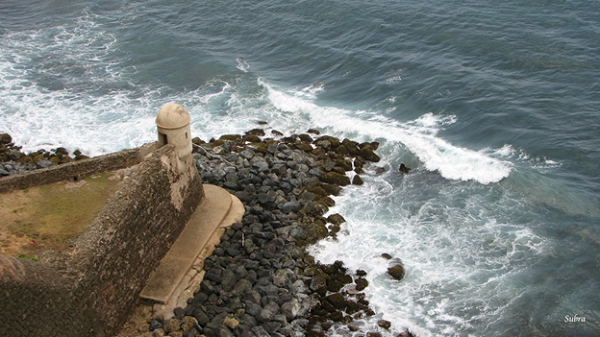
In 1493 Christopher Columbus set foot in the land of Taino Indians, a tropical paradise called Puerto Rico, marking it as the entrance to the West.
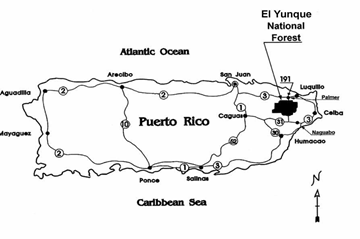 As the aircraft descends in San Juan, the sight of coconut palm trees swaying against the backdrop of the blue ocean beckons you to discover the secrets of Puerto Rico. We head towards Rio Grande in the eastern region of this island which is a short drive on Route 3, towards the lush green hills of the Luquillo mountains. Tucked away in a corner of this island lies the breathtaking El Yunque tropical rainforest, the only one of its kind in the US commonwealth. As we wind along Rt. 191 which is the approach road to El Yunque, you are surrounded by tall trees and a slew of ferns dotted along the way.
As the aircraft descends in San Juan, the sight of coconut palm trees swaying against the backdrop of the blue ocean beckons you to discover the secrets of Puerto Rico. We head towards Rio Grande in the eastern region of this island which is a short drive on Route 3, towards the lush green hills of the Luquillo mountains. Tucked away in a corner of this island lies the breathtaking El Yunque tropical rainforest, the only one of its kind in the US commonwealth. As we wind along Rt. 191 which is the approach road to El Yunque, you are surrounded by tall trees and a slew of ferns dotted along the way.
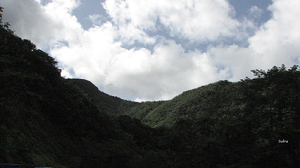 We reach the El Portal Visitor Center which is quite impressive, where a wooden walkway takes you through a canopy of tree tops and you begin to appreciate the dense foliage of the rainforest and its inhabitants. A short documentary highlights the beauty of El Yunque and the imminent need for conservation of such ecosystems for future generations to marvel and enjoy. The Puerto Rican Parrot, a highly endangered species. A small creek flows nearby gently over the rocks as you slowly take in the natural beauty around you and suddenly you spot a Gray Kingbird, endemic to this region, dart out of the woods to catch a fly and return to its roost. Then you hear the call of the Pearly Eyed Thrasher as we leave the visitor center to drive through the rain forest, which cools down as you ascend the winding hills.
We reach the El Portal Visitor Center which is quite impressive, where a wooden walkway takes you through a canopy of tree tops and you begin to appreciate the dense foliage of the rainforest and its inhabitants. A short documentary highlights the beauty of El Yunque and the imminent need for conservation of such ecosystems for future generations to marvel and enjoy. The Puerto Rican Parrot, a highly endangered species. A small creek flows nearby gently over the rocks as you slowly take in the natural beauty around you and suddenly you spot a Gray Kingbird, endemic to this region, dart out of the woods to catch a fly and return to its roost. Then you hear the call of the Pearly Eyed Thrasher as we leave the visitor center to drive through the rain forest, which cools down as you ascend the winding hills.
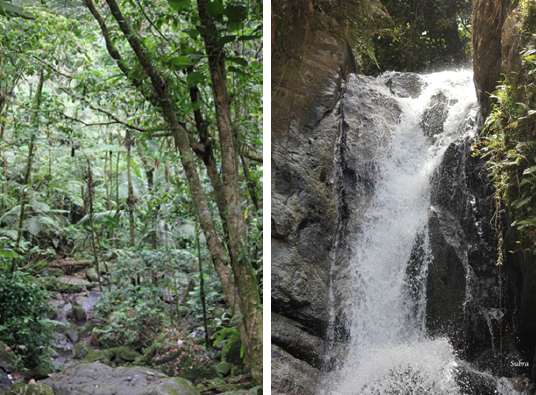
A couple miles later, we stop at La Coca Falls to get a glimpse of the waterfall as it trickles down the mountains while a cool breeze blows through the forest. A green lizard, the Puerto Rican Emerald Anole darts by and you are greeted by the sound of the Coqui, a diminutive tree frog which is more often heard than seen in this region and is barely a couple of inches in size.
Driving along hairpin bends, you watch out for oncoming vehicles as they whiz past. We drive towards the Yokuho observation tower to get a bird’s eye view of the rainforest. As we head towards the Big Tree Trail, it is almost impossible to find parking on the winding mountainous roadside, so we proceed further towards La Mina Falls. The park official at the Palo Colorado Interpretive Center tells us that the trails are closed for repairs, which is a big disappointment, but he advises us to go back to the Big Tree trail to reach La Mina. We stop by for a cold coconut drink at La Muralla, a popular roadside eatery. As night descends on the forest, the Coquis put on an impressive orchestra that is simply captivating! The Coqui is probably the only frog whose croak sounds musical, and is extremely precious and vital to this ecosystem!
The next day we head towards the Big Tree Trail and hit the well paved trails to be in communion with nature, as we hike through narrow streams and tall trees with exposed roots. These are Sierra Palms which have buttress roots that cling onto the ground, a form of adaptation. This is a fairly moderate trail and you are rewarded at the end with an absolutely breathtaking view of La Mina Falls as it gushes from the mountain top in a thundering cascade. La Mina is the crown jewel of El Yunque and is worth every penny. The return hike is not bad, as we bid adieu to the rainforest and head towards Hacienda Carabeli for some horseback riding through country farms to the foot of the tropical forest alongside gently flowing streams.
Nearby the clean sandy beaches of Luquillo, called Balnearios beckon, dotted with coconut palm trees and resplendent blue waters. Laughing Seagulls in their summer plumage are everywhere scouring for food and fighting with Greater Antilles Grackles, whilst graceful Brown Pelicans glide over the ocean. Not to miss are the numerous kioskos along the highway that serve fresh food including mofangos or fried plaintains.
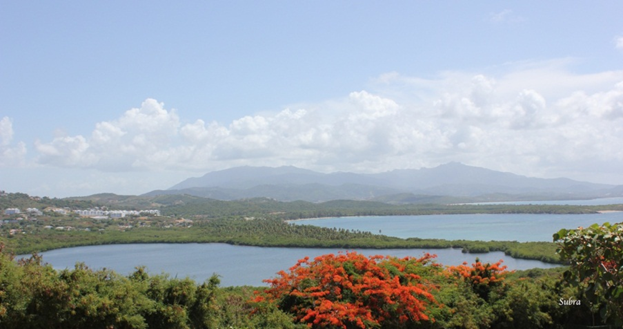
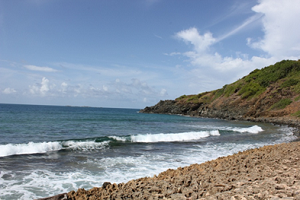 Further east in Fajardo is Las Cabezas de San Juan Nature Preserve where tour guides drive you around as you traverse multiple ecosystems from deciduous forests to mangrove swamps via sandy beaches. We call ahead for reservations as they are very particular about tour times. Iguanas roam around freely and termite mounds the size of a huge rock can be spotted on tree tops. Our guide tells us that these termites emit a pungent odor that is enough to shun away predators including humans. As we head up to the Lighthouse which is still in use, we get to see spectacular views of the bay and multiple islets therein, amidst the backdrop of mountains. Walking back on the boardwalk in the mangrove swamps, we hear a loud racket only to find a Black-necked Stilt flying towards us.
Further east in Fajardo is Las Cabezas de San Juan Nature Preserve where tour guides drive you around as you traverse multiple ecosystems from deciduous forests to mangrove swamps via sandy beaches. We call ahead for reservations as they are very particular about tour times. Iguanas roam around freely and termite mounds the size of a huge rock can be spotted on tree tops. Our guide tells us that these termites emit a pungent odor that is enough to shun away predators including humans. As we head up to the Lighthouse which is still in use, we get to see spectacular views of the bay and multiple islets therein, amidst the backdrop of mountains. Walking back on the boardwalk in the mangrove swamps, we hear a loud racket only to find a Black-necked Stilt flying towards us.
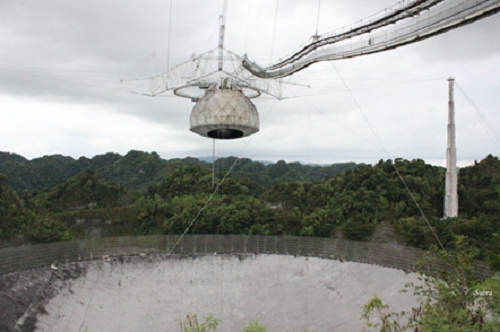
In the 60s, US scientists were looking for the perfect spot to build an Observatory to study exosolar planets and outer life and they located their dreamspot in Arecibo, an hour’s drive west of San Juan. Getting to Arecibo from Hwy 22 is quite an adventure as you traverse through narrow winding roads up the hills. A gigantic dish reflector atop the mountains picks up radiofrequency signals from distant galaxies and beams them upwards to an eerily placed dome structure dangling in mid-air tethered by long cables, which then transmits them to the control room. The observatory is funded by a consortium including NSF, Universidad de Puerto Rico and No signs of ET yet!
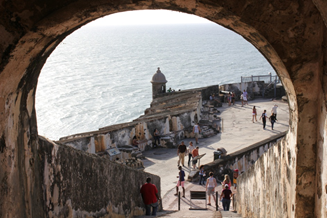 The best way to explore the historic city of Old San Juan is by foot, although free trolleys transport you back and forth within the walled city. Strolling along the cobblestone roads on Paseo de la Princesa in Old San Juan, time appears to stand still as you are transported back to the 15th century. Walking past the Raices fountain, we enter ‘San Juan gate’ and proceed towards the majestic El Morro fort. Climbing up the hill, we see several people flying kites while a cool sea breeze wafts by. El Morro was built in the early 1500s and stands majestically having survived the onslaught of countless wars. As the waves fiercely lash against the rocks, you marvel at the impenetrable walls of the fort and its remarkable architecture. At the topmost level cannon balls are displayed in a heap while several sentry boxes stand guard at strategic points. El Morro is a true testament to the vision of the settlers and the countless souls that toiled to build it.
The best way to explore the historic city of Old San Juan is by foot, although free trolleys transport you back and forth within the walled city. Strolling along the cobblestone roads on Paseo de la Princesa in Old San Juan, time appears to stand still as you are transported back to the 15th century. Walking past the Raices fountain, we enter ‘San Juan gate’ and proceed towards the majestic El Morro fort. Climbing up the hill, we see several people flying kites while a cool sea breeze wafts by. El Morro was built in the early 1500s and stands majestically having survived the onslaught of countless wars. As the waves fiercely lash against the rocks, you marvel at the impenetrable walls of the fort and its remarkable architecture. At the topmost level cannon balls are displayed in a heap while several sentry boxes stand guard at strategic points. El Morro is a true testament to the vision of the settlers and the countless souls that toiled to build it.
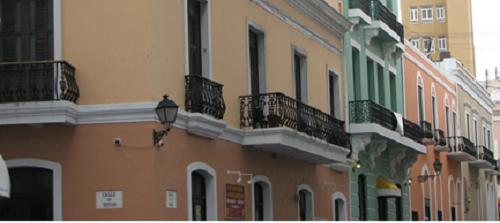
We head to Plaza de Colon where an impressive statue of Christopher Columbus marks the spot. Adjacent to this is another monument, Castillo de San Cristobal or the Cristobal Fort on the eastern flank of the old city. A self guided tour of this fort takes you through the soldiers quarters. Secret tunnels run through the length of this fort with hidden crevices containing detonators just in case the enemy showed up!
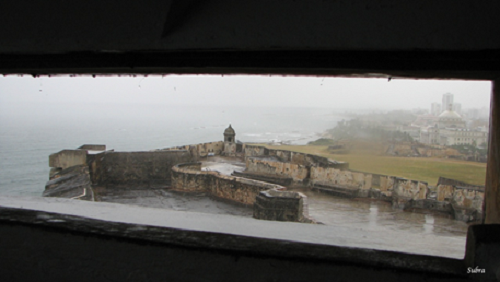
San Cristobal is a UNESCO natural heritage site and has been extrmely well preserved. We are caught off guard by a sudden downpour in the top open level of the fort and rush to get shelter in a small enclosure with narrow slits that offer panoramic views of this fabulous city including El Morro.
27-Aug-2012
More by : Subra Narayan